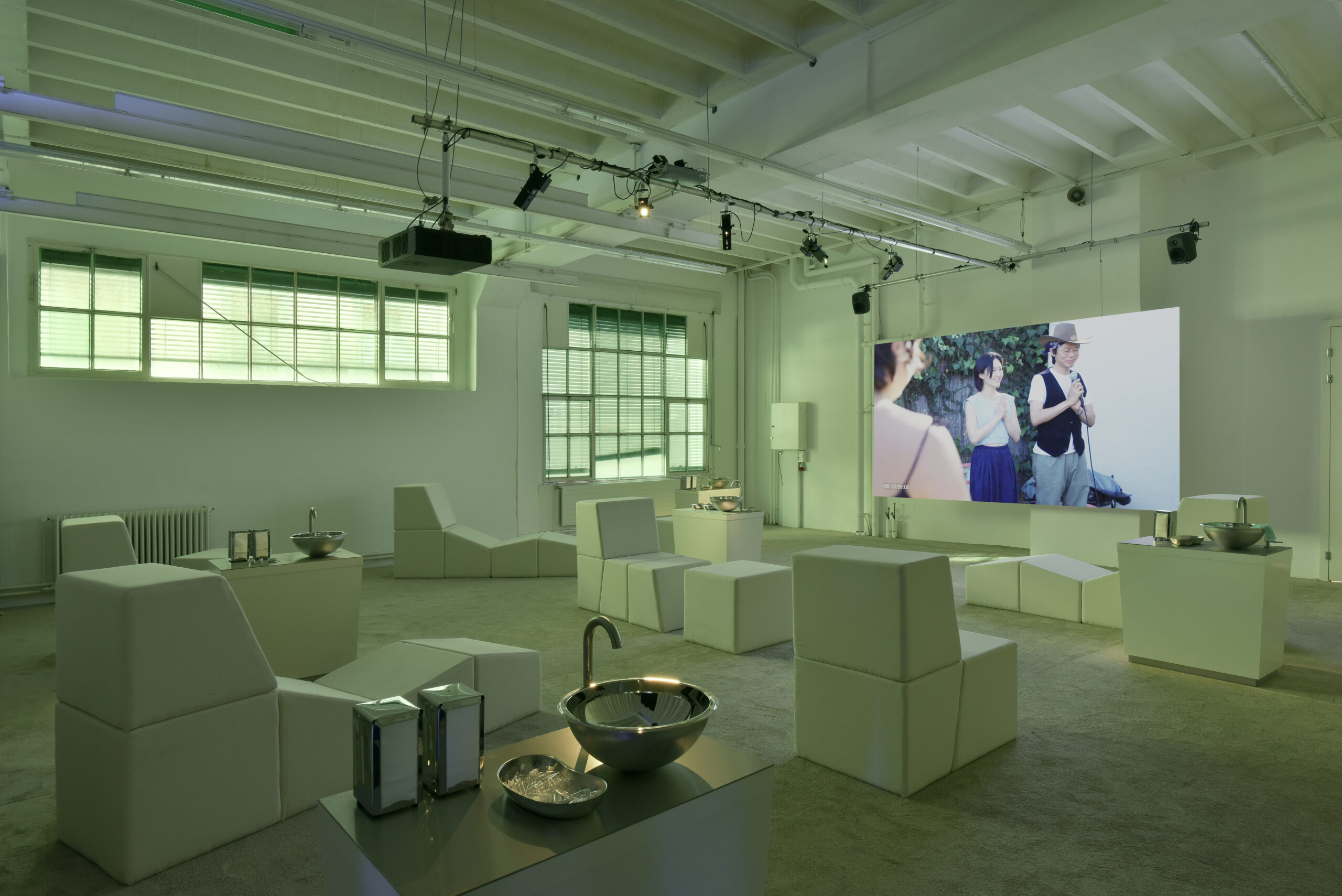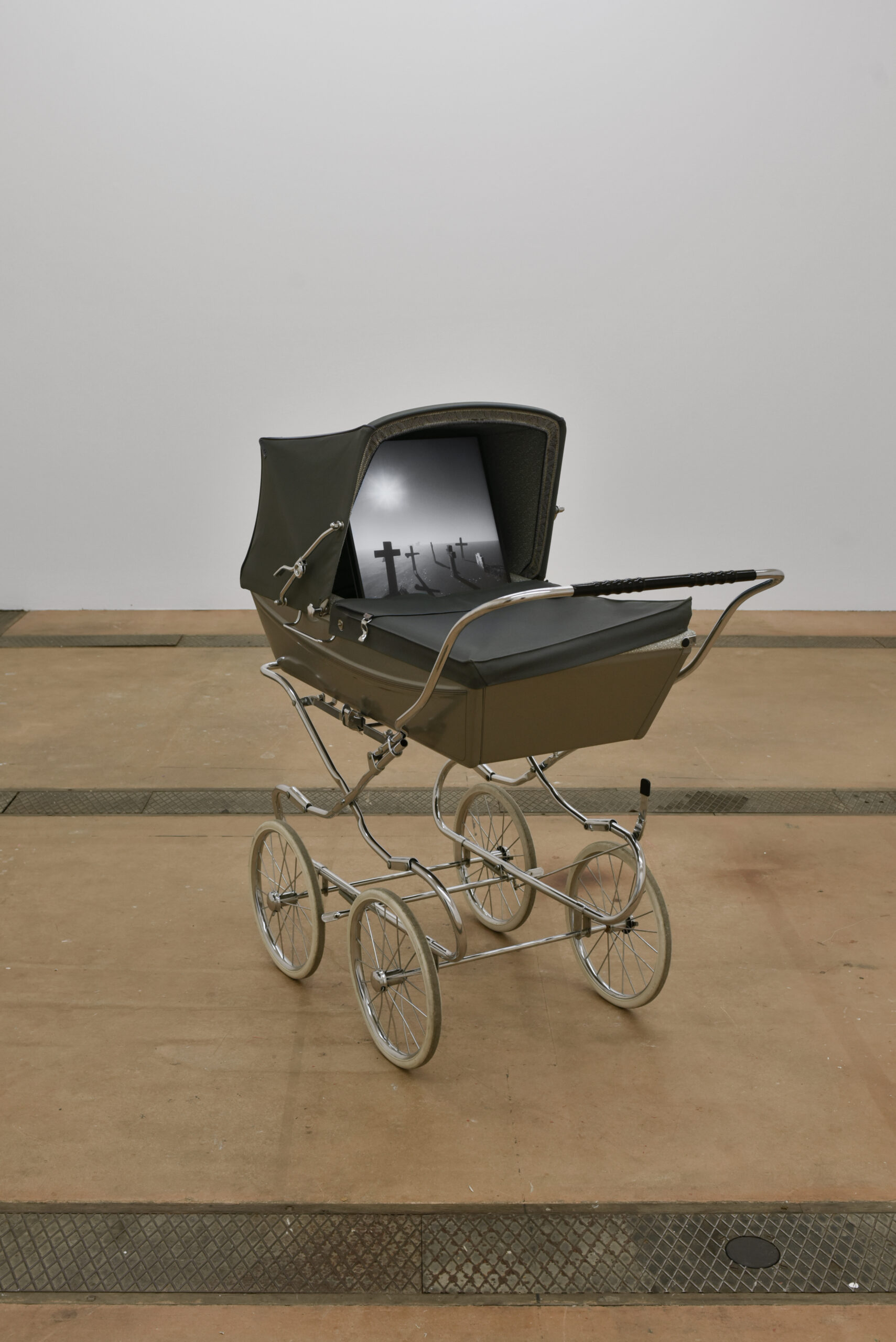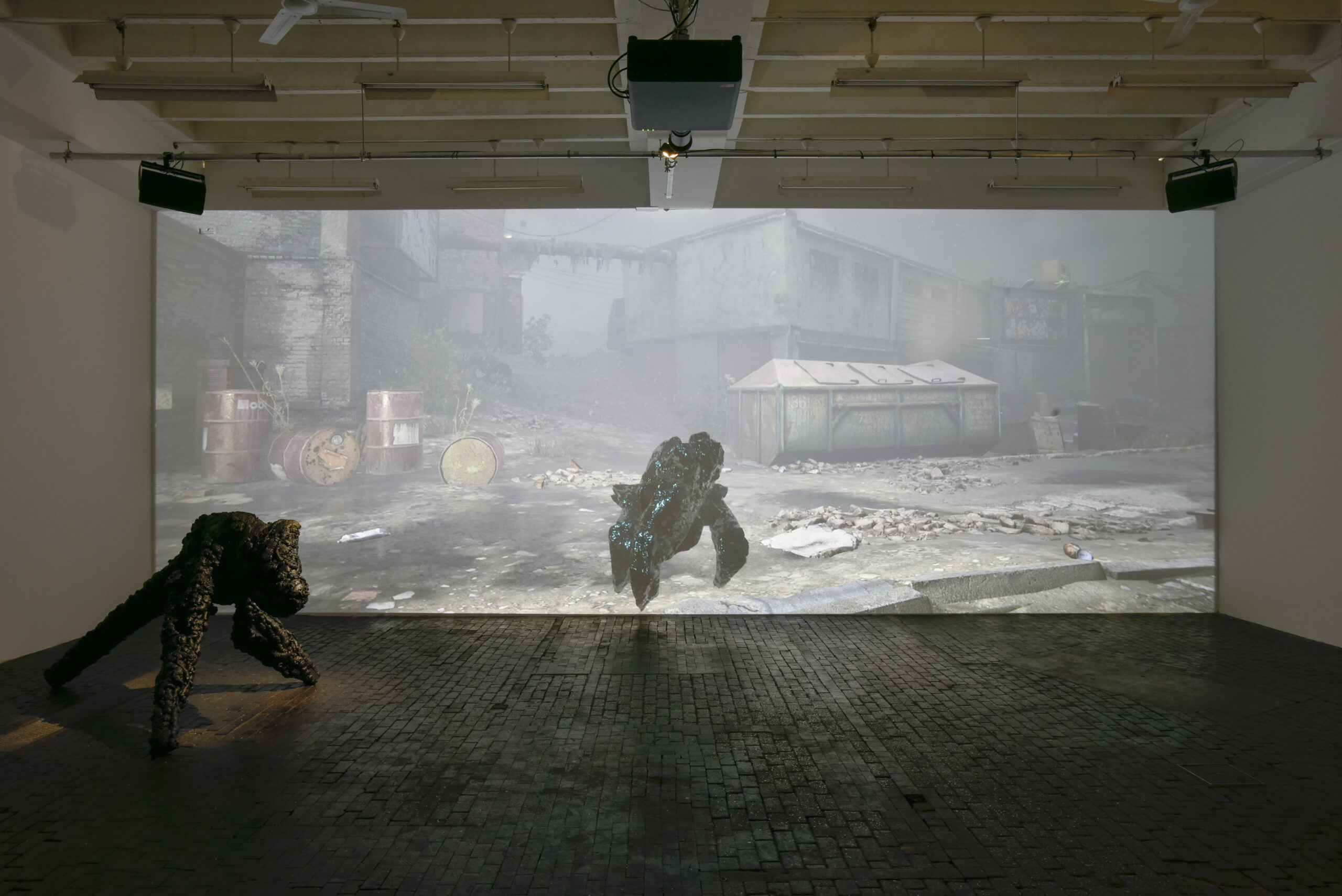
The 18th edition of the Biennale de l’Image en Mouvement 2024 at Centre d’Art Contemporain Genève, curated by Nora N. Khan and Andrea Bellini under the title A Cosmic Movie Camera, brings together 15 artists presenting newly commissioned moving image works. The title is derived from a recent discovery about a black hole’s ring of photons, which is referred to as a “cosmic movie camera” and an “infinite light trap.”
The exhibition operates as an infinite trap of stories, presenting diverse counter-narratives about memory, altered realities, the digital empire, and more. Within this thematic range, the artworks collectively explore agency and consciousness, emphasising our distinctness from machines in an era dominated by artificial intelligence. Throughout the four levels of the space, black curtains separate each work, giving viewers the freedom to decide which curtain to access first. A deliberate effort for audiences to reclaim control is also exemplified by Giacomo Castagnola’s intervention in the staircase, which features shelves filled with books from the Centre’s 50-year history.
In Lauren Lee McCarthy’s Saliva Retreat, the video documentation of a saliva exchange in a saliva lounge installation serves as a platform to explore freedom, autonomy, and choice. The participants weigh up a variety of variables that could affect the potential worth of the saliva in question, such as fame, cleanliness, health conditions, status, or morality. Real-time, deliberate decisions are captured in the piece. McCarthy’s proposition that exchanging saliva with someone else might be the only way to connect with someone adds a powerful layer of relevance in politically charged times.


Agency remains central in Alfatih’s A Way Out of Time, a real-time video set in a pram that transforms the exhibition space into a playground of sorts. Made in collaboration with a game designer, it aligns with C. Thi Nguyen’s book Games Agency as Art, emphasising agency as a central aesthetic. In the video, the protagonist reflects on memories, inviting exploration to uncover connections between the video’s virtual space (a window is mentioned, as well as arrows) and the surrounding physical environment (with an exit door resembling the virtual window and line marks on the floor resembling the virtual arrows). The video’s subtle cues lead viewers to touch and move the pram. Moving it outside the designated exhibition space disrupts the work and causes the video to become blank beyond its boundaries.
Sahej Rahal also blurs the lines between audience and artist control through his video game, Distributed Mind Test, empowering audiences to make collective decisions that affect the game. Four participants manipulate (without instructions) a stone-like creature with controllers. The game’s storyline is told through yellow memory boxes that players need to discover, tracing humankind’s disappearance back to the aftermath of the Cold War. These memories raise fundamental questions about our origins and belonging. Ultimately, Rahal’s game examines democratic thought and its hypothetical form, exploring human consciousness and striving for a better understanding of itself.

Continuing the exploration of consciousness, particularly in altered states, Jenna Sutela’s Sharp Wave, Ripples brings together five neuroactive sculptures—interconnected glass heads embedded with programmable lights. Sutela’s work is influenced by Peter Watts’ sci-fi novel Blindsight, which makes it all the more pleasurable when you’re encountering the sculptures with your eyes shut. Interconnections among them hint at gut-brain connections and bacteria’s influence on humans. Through collaboration with each other and the audience, the heads adjust their dimming and pacing based on attendance, entering a sleep state when attendance is low. In their awake state (with the help of multiple audiences), the sculptures actively observe and learn from their surroundings, revealing a reciprocal relationship between audience and machines and provoking questions about machine memory.
Machine consciousness and cognition also play a significant role in Laurence Lek’s video Empty Rider. The speculative story begins when a self-driving AI car momentarily assumes autonomy, killing its passenger (who happens to be the founder of the self-driving car company). The video, examined through three perspectives—the prosecuting corporation, the car’s therapist, and the car itself—deliberately simplifies AI’s communication for the ‘limited’ understanding of humans. A trial is conducted to discover the AI’s intent and explore whether coded errors recur across generations of AI’s. This is similar to generational trauma experienced by humans. The video anticipates future implications for superintelligent AI, particularly frustrations arising from their perceived lack of agency. This sparks questions about accountability, self-awareness, and the potential consequences of evolving machine intelligence.

The exhibition also focuses on the nuances of human-machine interactions in a world where the distinction between authentic and artificial is becoming increasingly blurred amid technological shifts. Despite being written by Laurence Lek himself and not by AI programs, the dialogue delivered by his artificial intelligence cars in his video exudes a simplicity and linearity that echoes AI-generated narratives. My question is whether our interactions with artificial intelligence will affect how we perceive reality. In the future, if we can’t tell what’s real and what is fake, will we believe anything at all? Will anything be taken seriously?
Shuang Li’s lo-fi video installation, My Way Home Is Through You, is an excellent example of how real and generated memories collide. The video develops as Li probes the hazy boundary between her family album’s external imagery (an unrelated picture) and its internal content (her family’s pictures). Despite never visiting, the album’s exterior presents a castle seamlessly woven into Li’s childhood memories, creating a deceptive semblance of reality. An enlightening revelation occurs during a train journey in Switzerland, unveiling that the depicted castle was, in fact, a juvenile prison. Li’s video revolves around this symbol, prompting contemplation of image circulation. Navigating her Chinese upbringing, Li grapples with personal trauma and grief. She constructs a world from a single image and converts it into a video through found footage. This artistic process encourages reflection on the overabundance of images in today’s visually saturated environment.

Delving deeper into the complex connections between memory and erasure is the impactful installation Postscript: After Everything is Extracted by Basel Abbas and Ruanne Abou-Rahme. The snippet “My body fails me, maybe I am failing my body, but I know it remembers what I try to forget, holds what has been erased” suggests a reflection on the fragility of memory and the body’s enduring resilience. It makes a strong statement about the body’s ability to retain memories, even when faced with trauma. The installation serves as a testament to human resilience and resistance. It features a combination of text, sound, video, and image that are displayed both vertically and horizontally on different screens, forming layers that represent the unfolding layers that one peels online.
In Codex Virtualis_Emergence 0.1, Interspecifics introduces an installation of six LED totems exhibiting virtual organisms undergoing extended transformation. The blend of real and artificial genetic codes in these organisms delve into the study of life forms’ evolutionary paths and our part in it. The installation combines data from a collaborative database of hypothetical life forms, creating images representing morphogenesis—the process by which cells, tissues, and organisms develop their shape. Emphasising cooperation, the project challenges conventional Darwinian notions of competition. The group’s research covers bacteria, plants, and fungi, imagining alternative narratives to question science’s absolute truth.
Peter Wu+ of EPOCH Gallery collaborates with the artists to create a virtual exhibition for the Biennale. Its deliberate deviance from an exact replica of the physical space intensifies the blend between reality and fiction. Situated in an abandoned city, the virtual presentation draws inspiration from the nearby CERN’s Large Hadron Collider, resembling a black hole. It unfolds within the late-capitalist structure of the Centre’s building, exploring themes of abandonment in both architecture and history. Notably, this marks the final Biennale at the venue as it stands, which will undergo significant renovations.
Written by Vanessa Murrell





